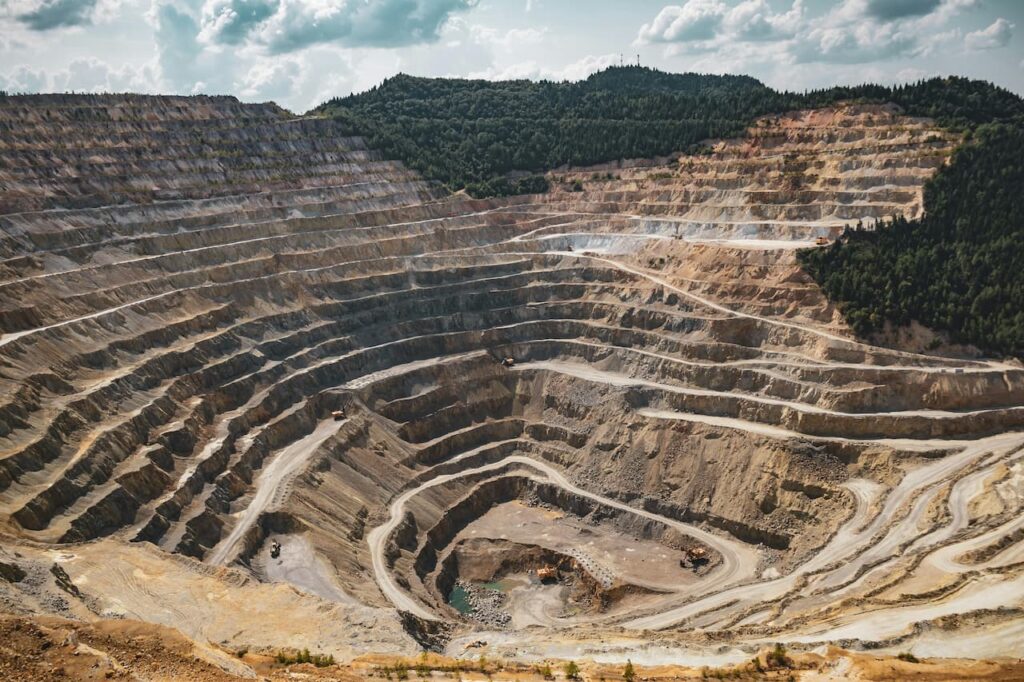Open-pit mining (OPI), opencast mining, or surface mining is widely used for extracting minerals or geological materials from the earth. This method involves digging a large open hole or pit from which the ore or mineral is extracted. OPI is commonly used for copper, gold, iron, and gravel minerals.
The Process of OPI
The OPI process begins with the identification of a mineral deposit. Geological surveys and exploratory drilling are conducted to determine the feasibility of digging in a particular area. Once a mineral deposit is confirmed, the next step is to plan the extraction process.
Planning and Design
OPI’s planning and design phase is crucial for ensuring the efficient and safe extraction of minerals. Engineers and geologists work together to determine the optimal pit size, shape, and depth. Factors such as ore grade and quality, topography, and environmental considerations are considered during the planning phase.
Stripping
Stripping is the initial phase of OPI, where overburden or waste materials are removed to expose the ore. Overburden refers to the layer of soil or rock covering the ore body. This is removed using heavy earth moving equipment, such as bulldozers and excavators, and transported to nearby designated areas.
Blasting
Once the burden is removed, the next step is to blast the ore using explosives. Controlled and precise explosions break the ore into smaller fragments, making extracting it easier. The timing and amount of explosives used are carefully calculated to minimize damage to the surrounding areas.
Extraction
After blasting, the ore is loaded onto haul trucks and transported to a processing plant for further refining. Excavators or front-end loaders are used to load the ore onto the trucks, which are sized depending on the scale of the digging operation.
Processing and Refining
The ore is crushed, ground, and chemically treated at the plant to extract the valuable minerals. Various techniques such as flotation, gravity separation, and smelting are used to separate the minerals from the unwanted materials. The refined minerals are then transported to smelters or refineries for further processing.
Rehabilitation and Closure
Once the extraction process is complete, the pit is rehabilitated and restored to its natural state. This includes contouring the land, re-vegetating the area, and restoring waterways. Environmental monitoring and management are ongoing throughout the digging operation to ensure compliance with regulations and minimize adverse impacts.
Advantages of OPI
Open-pit mining offers several advantages over other digging methods:
1. High production rate: OPI allows for the extraction of significant minerals or ore in a relatively short period. This leads to excellent production rates compared to below-ground mining.
2. Large-scale operations: OPI is well-suited for large-scale digging operations, making it suitable for mining companies with significant financial resources.
3. Lower operating costs: OPI tends to have lower operating costs than below-ground mining. This is due to the reduced ventilation, support systems, and infrastructure requirements.
4. Accessibility: OPI allows for easy access to the minerals or ore, making it more efficient and economical to extract than below-ground digging.
5. Flexibility: OPI offers flexibility in the extraction process. The pit can be widened or deepened to access further mineral deposits.

Environmental Impacts of OPI
While OPI has its advantages, it also comes with some environmental impacts:
1. Habitat destruction: OPI involves moving large amounts of soil and vegetation, leading to habitat destruction for plants and animals.
2. Water pollution: The extraction and processing of minerals can lead to water pollution by discharging contaminated water into waterways.
3. Air pollution: Dust and particulate matter generated during OPI operations can contribute to air pollution, especially in dry and windy conditions.
4. Land degradation: Excavating and removing soil and rock can result in land degradation, leaving scars on the landscape.
Safety Measures in OPI
Safety is of utmost importance in OPI operations. Various safety measures are implemented to protect workers and minimize any hazards:
1. Training and education: Workers undergo comprehensive training and education on properly using equipment, handling explosives, and safety protocols.
2. Personal protective equipment (PPE): To minimize the risk of injuries, Workers are provided with appropriate personal protective equipment (PPE) such as helmets, safety goggles, gloves, and steel-toed boots.
3. Equipment maintenance: Regular maintenance and inspection of equipment are conducted to ensure their proper functioning and minimize the risk of accidents.
4. Strict laws: OPI operations are subject to strict safety laws and guidelines enforced by local authorities to ensure compliance and minimize risks.
5. Emergency preparedness: Emergency response plans are in place to address potential accidents or incidents. This includes evacuation procedures, first aid stations, and communication systems.
Conclusion
OPI is a widely used method for extracting valuable minerals or ore from the earth. It offers high production rates, large-scale operations, and lower operating costs than below-ground mining. However, it has several environmental impacts, including habitat destruction, water and air pollution, and land degradation. Safety measures and strict regulations are implemented to protect workers and minimize hazards. As with any digging operation, a balanced approach considering economic and environmental factors is crucial for sustainable and responsible mining practices.